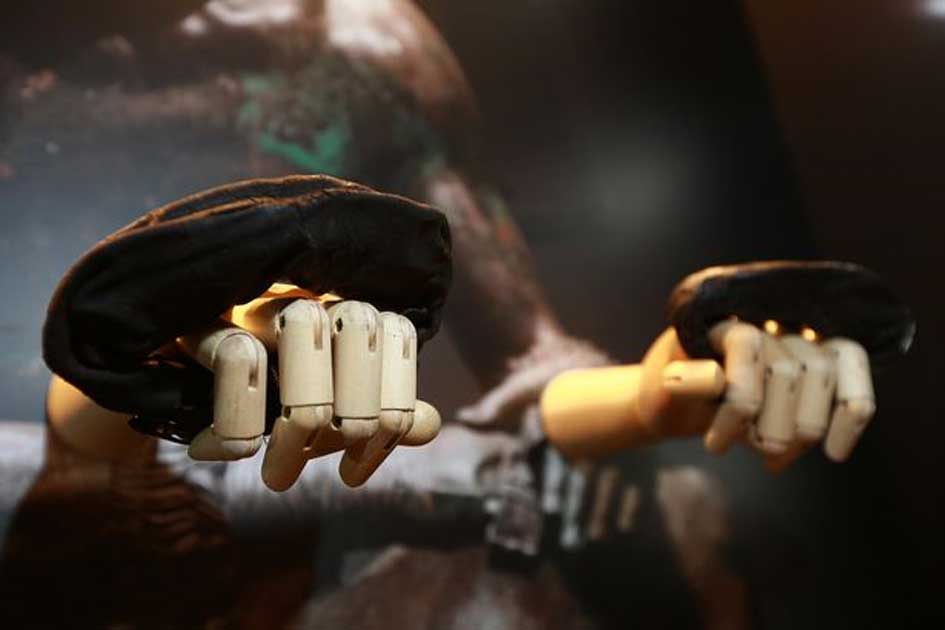Heavy Hitters: 2,000-Year-Old Boxing Gloves Suggest Roman Soldiers Used to Duke It Out
Still molded to the form of their former owner’s knuckles, boxing gloves found at the Roman site of Vindolanda in Northumberland, England hint at tales of soldiers increasing their battle skills, keeping up their fitness, and passing the time gambling on fights while stationed in the far northern lands of the empire.
The summer of 2017 was a remarkable one for Vindolanda archaeologists. While exploring the ruins of the Roman site near Hadrian’s wall they unearthed a wealth of artifacts – from the thin wooden Vindolanda Writing Tablets covered in cursive script to swords, shoes, and dice, excavators had a uniquely amazing year. But one specific find was the undisputed champion– a pair of one of a kind boxing gloves that have rolled with the punches of time.

These are leather boxing gloves from the Roman period. (Vindolanda Trust)
The boxing gloves are not only noteworthy for outstanding preservation, but Vindolanda Trust reports they are an extremely rare discovery. A press release on the Roman artifacts states, “Research of the objects at Vindolanda along with the considered observations by Roman leather and other experts has indicated that these leather objects are in fact boxing gloves and probably the only known surviving examples from the Roman period.”
- Two Roman Cavalry Swords and Two Toy Swords Amongst Treasures Found at Frontier Fort
- Adidas of Ancient Rome: Ancient Fashion Unveiled with Discovery of Roman Shoe Hoard
According to ChronicleLive, the two gloves were found in a location identified as the cavalry barracks of the Vindolanda fort. The boxing gloves date to approximately 120 AD and are a testament to sparring matches which probably took place amongst members of the garrison. Patricia Birley, former director of the Vindolanda Trust who is now focused on conservation and research at the site, told ChronicleLive, “Boxing is an ancient sport and it was practised in the Roman army as a keep fit exercise and probably in combat contests between units, rather like the way the modern army still has its tournaments.”

The boxing gloves on display in the museum. (Vindolanda Trust)
Thus, the boxing gloves demonstrate some general habits amongst Roman soldiers, but they also have a personal touch. Birley explained,
“Items like the gloves are a very personal link to the Romans at Vindolanda. You can still put your hands into the gloves and can see where the knuckles of the owner have moulded into the leather […] The larger one has been patched and repaired but has been kept probably because the owner valued it.”
Vindolanda Trust reports that the gloves are not a matched pair and although they were skillfully made they were probably not meant for “professional” boxing matches. Most likely the gloves served more as a protective guard for the knuckles of their wearer. The larger glove was made from one piece of leather folded and filled with a natural material which acted as a shock absorber. The smaller glove was made in a similar fashion but filled with hard twisted leather instead.

Detail of one of the Roman boxing gloves found at Vindolanda. (Newcastle Chronicle)
BBC News reports of the impact the boxing gloves had on Dr. Andrew Birley, Vindolanda Trust director of excavations. Dr. Birley said,
"I have seen representations of Roman boxing gloves depicted on bronze statues, paintings and sculptures, but to have the privilege of finding two real leather examples is exceptionally special. The hairs stand up on the back of your neck when you realise you have discovered something as astonishing as these boxing gloves."
- Archaeologists Uncover Spine-tingling New Hoard of Roman Letters at Vindolanda Fort
- True Path of Hadrian's Wall Excavated in Newcastle

Vindolanda Trust’s CEO, Dr. Andrew Birley next to the Roman boxing gloves on display at the museum. (Hexham Courant)
The boxing gloves may be knockout artifacts these days, but they are just one of about 20,000 leather items that have been found at Vindolanda. 8,000 of the leather items are shoes.
Other noteworthy finds from last season’s work include horse gear, complete swords, writing tablets, combs, and dice. Some of these artifacts will undoubtedly join others in the Vindolanda museum. ChronicleLive says that the new excavation season is set to begin in the first week of April.
Top Image: The first ever Roman boxing gloves found in Britain are now on display at Vindolanda. Source: Coventry Telegraph



















